指示形容词与指示代词(中英西法对照表)
初中语法大全讲解--指示代词
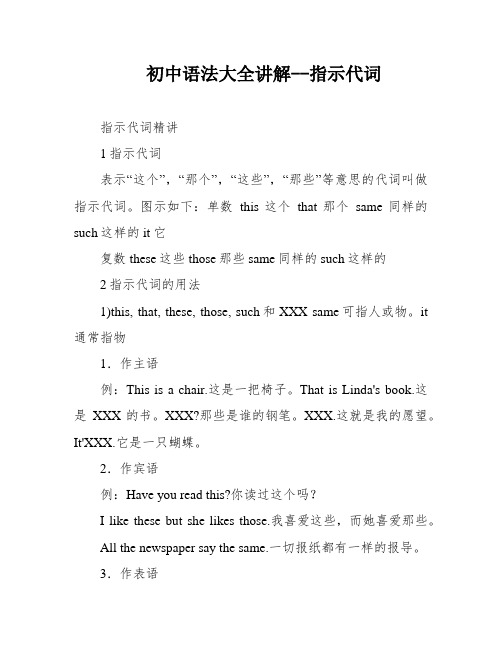
初中语法大全讲解--指示代词指示代词精讲1指示代词表示“这个”,“那个”,“这些”,“那些”等意思的代词叫做指示代词。
图示如下:单数this这个that那个same同样的such这样的it它复数these这些those那些same同样的such这样的2指示代词的用法1)this, that, these, those, such和XXX same可指人或物。
it 通常指物1.作主语例:This is a chair.这是一把椅子。
That is Linda's book.这是XXX的书。
XXX?那些是谁的钢笔。
XXX.这就是我的愿望。
It'XXX.它是一只蝴蝶。
2.作宾语例:Have you read this?你读过这个吗?I like these but she likes those.我喜爱这些,而她喜爱那些。
All the newspaper say the same.一切报纸都有一样的报导。
3.作表语例:Her plan is this.她的打算是如许的。
His XXX.他的懊恼就是那些。
4.作定语例:You can't swim at this time of the year.你不克不及在这个时分泅水。
I don't like that man.我不喜爱那小我。
She is fond of those books.她喜爱那些书。
2)唆使代词的用法区分1.this和these普通指在空间和工夫上较近的事物,that 和those普通指在空间和工夫上较远的事物。
例:This is a map of China and that is a map of the world.这是一张中国舆图,那是一张天下舆图。
Please come this way. We'll go in by that door.请这边走,我们从那扇门出来。
In those year they led a hard life.在那些光阴里,他们糊口得很困难。
西班牙语语法完整版解析

西班牙语语法大全西班牙语的一般特点。
Pedro está en casa, y sus hermanas han ido a una tienda cercana. 彼得罗在家里,而他的姐妹们去了附近一家商店。
一、名词的阴、阳性和单、复数1.名词的性(Género del sustantivo)西班牙语的名词有阳性和阴性之别可以根据词尾来加以辨认:* 以o结尾的名词大多为阳性。
如:plato (盘子), oso (公熊), pato (雄鸭)但有少数以o结尾的名词为阴性。
如:foto(照片), moto (摩托车), mano (手)* 以a 结尾的名词大多为阴性。
如:mesa (桌子), pluma (钢笔), camisa (衬衣)但有少数以a 结尾的名词为阳性。
如:mapa (地图),sofá(沙发), problema (问题),sistema (系统)* 用缩写形式m. (masculino)表示阳性,f. (femenino)表示阴性。
* 以其他元音或辅音结尾的名词的词性没有一定之规estudiante m. f.* 阳性名词变阴性形式以o结尾的名词,把o改为a 而构成阴性形式。
hijo 儿子— hija 女儿abuelo 祖父,外公— abuela 祖母,外婆perro 狗— perra 母狗以辅音结尾的阳性名词,一般在辅音后加上a 构成阴性形式。
seor 先生— seora 女士,夫人pintor 画家— pintora 女画家某些名词阳性变阴性时,词尾变化不规则。
actor 演员— actriz 女演员有些名词阴性、阳性形式各不相同。
padre 父亲— madre 母亲caballo 公马— yegua 母马gallo 公鸡— gallina 母鸡阳性名词以a 结尾,在变成阴性形式时不能再改变词尾。
artista, pianista, periodista.argentino --- argentina2.名词的数(Número del sustantivo)名词有数的范畴。
二外法语语法-指示词,主有词, 泛指词和数量表达法
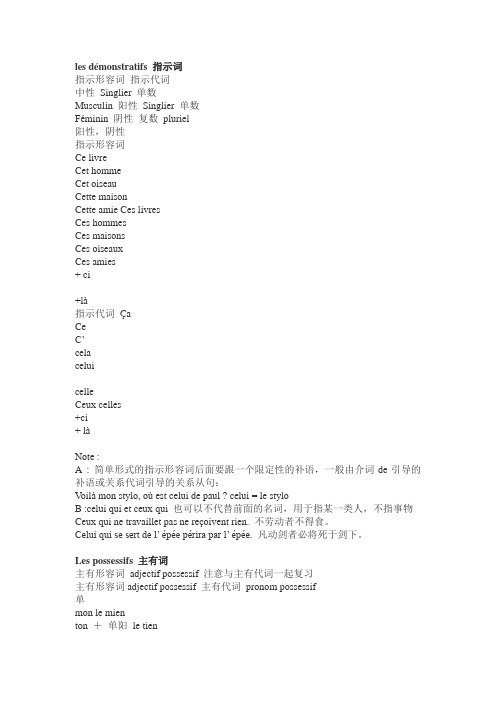
les démonstratifs 指示词指示形容词指示代词中性Singlier 单数Musculin 阳性Singlier 单数Féminin 阴性复数pluriel阳性,阴性指示形容词Ce livreCet hommeCet oiseauCette maisonCette amie Ces livresCes hommesCes maisonsCes oiseauxCes amies+ ci+là指示代词ÇaCeC’celaceluicelleCeux celles+ci+ làNote :A : 简单形式的指示形容词后面要跟一个限定性的补语,一般由介词de引导的补语或关系代词引导的关系从句:V oilà mon stylo, où est celui de paul ? celui = le styloB :celui qui et ceux qui 也可以不代替前面的名词,用于指某一类人,不指事物Ceux qui ne travaillet pas ne reçoivent rien. 不劳动者不得食。
Celui qui se sert de l’ épée périra par l’ épée. 凡动剑者必将死于剑下。
Les possessifs 主有词主有形容词adjectif possessif 注意与主有代词一起复习主有形容词adjectif possessif 主有代词pronom possessif单mon le mienton +单阳le tienson le sien单ma la mienneta + 单阴la tiennesa la sienne单阳阴mes les miens les miennestes + 复数les tiens les tiennesses les siens les siennes复数notre le notre la notrevotre + 单数le vôtre la vôtreleur le leur la leur复数阳Notrevotre + 复数leurs les notres复数阴les vôtresNos les leursV os + 复数Leurs泛指词和数量表达法les indéfinis et l’expression de la quantité ①les pronomes indéfinis 泛指代词les adjectifs indéfinis泛指形容词toutaucun chaque certain rien on②数量的表达法Plusieurs nom plurielQuelques + nom plurielNe...aucune(e) nom singulierAssezTropBeaucoupPlus +de +nom (sans article)MoinsAutantUn peu/peu。
法语语法形容词的用法
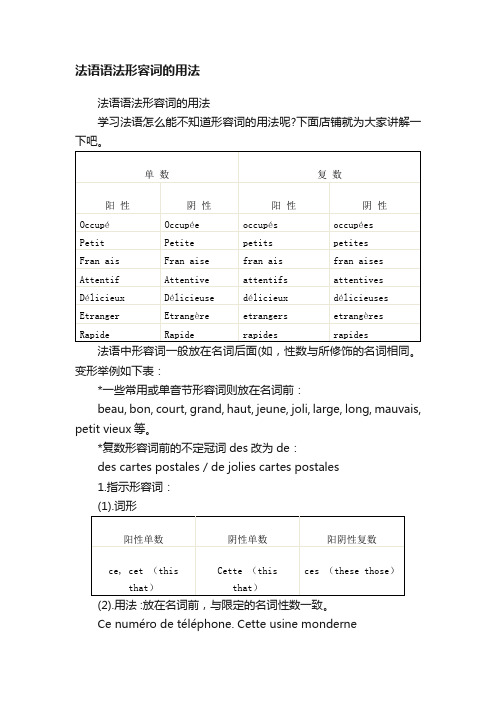
法语语法形容词的用法法语语法形容词的用法学习法语怎么能不知道形容词的用法呢?下面店铺就为大家讲解一下吧。
法语中形容词一般放在名词后面(如,性数与所修饰的名词相同。
变形举例如下表:*一些常用或单音节形容词则放在名词前:beau, bon, court, grand, haut, jeune, joli, large, long, mauvais, petit vieux等。
*复数形容词前的不定冠词des改为de:des cartes postales / de jolies cartes postales1.指示形容词:(1).词形Ce numéro de téléphone. Cette usine monderneCet用于元音字母或哑音h开头阳性单数名词前 cet arbre*也可以和副词词缀-ci, -là合用 ce roman-ci / cette revue-là2.疑问形容词和感叹形容词:(1).词形:(2).用法:与英文中的what, which相同,名词前或用作表语。
Quelle heure est-il ? Quelle langue étrangère étudiez-vous ?感叹形容词 Quel temps !3.品质形容词:1. 品质形容词有性、数的变化,其变化应和它所修饰的名词一致。
a.构成阴性形容词一般在阳性单数形式后面加上-e,如果形容词阳性形式是以e结果的,阴性形式不变。
b.以-el,-eil,-en,-on,-et结尾的阳性形式,构成阴性时,要重复词尾的辅音字母,再加上e。
如:bon --- bonnec.以-eur,-eux结尾的阳性形式,构成阴性形式时将-eur,-eux 改变-euse。
如:flatteur --- flatteused.构成复数形容词一般在词尾加上-s,如果要改成阴性复数,则先要把形容词变成阴性后再加s变成复数。
完整版英语语法术语中英文对照表
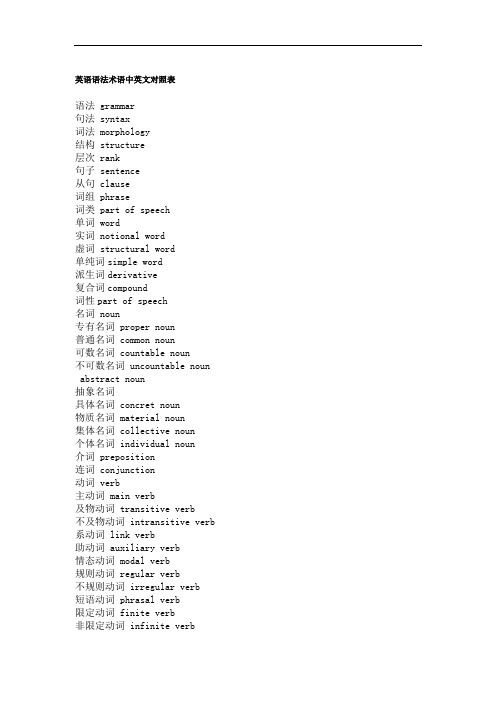
英语语法术语中英文对照表语法 grammar句法 syntax词法 morphology结构 structure层次 rank句子 sentence从句 clause词组 phrase词类 part of speech单词 word实词 notional word虚词 structural word单纯词simple word派生词derivative复合词compound词性part of speech名词 noun专有名词 proper noun普通名词 common noun可数名词 countable noun不可数名词 uncountable noun abstract noun抽象名词具体名词 concret noun物质名词 material noun集体名词 collective noun个体名词 individual noun介词 preposition连词 conjunction动词 verb主动词 main verb及物动词 transitive verb不及物动词 intransitive verb 系动词 link verb助动词 auxiliary verb情态动词 modal verb规则动词 regular verb不规则动词 irregular verb短语动词 phrasal verb限定动词 finite verb非限定动词 infinite verb使役动词 causative verb感官动词 verb of senses动态动词 event verb静态动词 state verb感叹词 exclamationadjective形容词副词 adverb方式副词 adverb of manner程度副词 adverb of degree时间副词 adverb of time地点副词 adverb of place修饰性副词 adjunct连接性副词 conjunct疑问副词 interogative adverb关系副词 relative adverb代词 pronoun人称代词 personal pronoun物主代词 possesive pronoun反身代词 reflexive pronoun相互代词 reciprocal pronoun指示代词 demonstrative pronoun疑问代词 interrogative pronoun关系代词 relative pronoun不定代词 indefinite pronoun物主代词 possecive pronoun名词性物主代词 nominal possesive prnoun形容词性物主代词 adjectival possesive pronoun 冠词 article定冠词 definite articleindefinite article不定冠词数词 numeral基数词 cardinal numeral序数词 ordinal numeral分数词 fractional numeral形式 form单数形式 singular form复数形式 plural form限定动词 finite verb form非限定动词 non-finite verb form原形 base form从句 clause从属句 subordinate clause并列句 coordinate clause名词从句 nominal clause定语从句 attributive clause状语从句 adverbial clause宾语从句 object clause主语从句 subject clause同位语从句 appositive clause时间状语从句 adverbial clause of time地点状语从句 adverbial clause of place方式状语从句 adverbial clause of manner让步状语从句 adverbial clause of concessionadverbial clause of cause原因状语从句.结果状语从句 adverbial clause of result目的状语从句 adverbial clause of purpose条件状语从句 adverbial clause of condition真实条件状语从句 adverbial clause of real condition非真实条件状语从句 adverbial clause of unreal condition 含蓄条件句 adverbial clause of implied condition错综条件句 adverbial clause of mixed condition句子 sentence简单句 simple sentence并列句 compound sentence复合句 complex sentence并列复合句 compound complex sentence陈述句 declarative sentence疑问句 interrogative sentence一般疑问句 general question特殊疑问句 special question选择疑问句 alternative question附加疑问句 tag question反义疑问句 disjunctive question修辞疑问句 rhetorical question感叹疑问句 exclamatory question存在句 existential sentence肯定句 positive sentencebasic sentence patern基本句型否定句 negative sentence祈使句 imperative sentence省略句 elliptical sentence感叹句 exclamatory sentence句子成分 members of sentences主语 subject谓语 predicate宾语 object双宾语 dual object直接宾语 direct object间接宾语 indirect object复合宾语 complex object同源宾语 cognate object补语 complement主补 subject complement宾补 object complement表语 predicative定语 attribute同位语 appositive状语 adverbial句法关系 syntatic relationship 并列 coordinate从属 subordinationmodification修饰.前置修饰 pre-modification后置修饰 post-modification限制 restriction双重限制 double-restriction非限制 non-restriction数 number单数形式 singular form复数形式 plural form规则形式 regular form不规则形式 irregular form格 case普通格 common case所有格 possessive case主格 nominative case宾格 objective case性 gender阳性 masculine阴性 feminine通性 common中性 neuter人称 person第一人称 first person第二人称 second personthird person第三人称.时态 tense过去将来时 past future tense过去将来进行时 past future continuous tense过去将来完成时 past future perfect tense一般现在时 present simple tense一般过去时 past simple tense一般将来时 future simple tense现在完成时 past perfect tense过去完成时 present perfect tense将来完成时 future perfect tense现在进行时 present continuous tense过去进行时 past continuous tense将来进行时 future continuous tense过去将来进行时 past future continuous tense现在完成进行时 present perfect continuous tense 过去完成进行时 past perfect continuous tense语态 voice主动语态 active voice被动语态 passive voice语气 mood陈述语气 indicative mood祈使语气 imperative mood否定 negationscope of negation否定范围.全部否定 full negation局部否定 partial negation转移否定 shift of negation语序 order自然语序 natural order倒装语序 inversion全部倒装 full inversion部分倒装 partial inversion直接引语 direct speech间接引语 indirect speech自由直接引语 free direct speech自由间接引语 free indirect speech一致 agreement主谓一致 subject-predicate agreement语法一致 grammatical agreement概念一致 notional agreement就近原则 principle of proximity强调 emphasis重复 repetition语音 pronunciation语调 tone升调 rising tone降调 falling tonefalling-rising tone降升调.文体 style正式文体 formal非正式文体 informal口语 spoken/oral English套语 formulistic expression 英国英语 British English美国英语 American English 用法 usage感情色彩 emotional coloring 褒义 commendatory贬义 derogatory幽默 humorous讽刺 sarcastic挖苦 ironic。
法语-语法结构表

法语语法结构表1. 形容词的性法语形容词的性和数要和他们所修饰的名词相一致。
因此,法语形容词相应的有四种形式:阳性单数、阴性单数、阳性复数和阴性复数。
1. 形容词的阴性形式一般在阳性形式后面加字母-e即可。
阳性形容词:Un petit garçon.一个小男孩。
阴性形容词:Une petite fille.一个小女孩。
以-e结尾的阳性形容词变成阴性时,形式不发生改变:Un travail facile.一份容易的工作。
Une question facile.一个简单的问题。
以-el、-eil和双 -l结尾的阳性形容词变成阴性形式时,在后面加 -e:Un problème éventuel.一个可能(发生)的问题。
Une solution éventuelle.一个可行的解决方法。
以-en、-on结尾的阳性形容词变成阴性形式时,双写-n后加-e:Un ancien élève.一个老(过去的)学生。
Une ancienne élève.一个老(过去的女)学生。
以-et结尾的阳性形容词变成阴性形式时,双写-t,然后加-e:Un homme muet.一个哑巴。
Une femme muette.一个女哑巴。
特殊情况:以下形容词变成阴性形式时,把 -et变成-ète:un plan secret一个秘密计划une pensée secrète一个秘密的想法以-x结尾的阳性形容词通常变-x为-se构成阴性形式:Un homme généreux.一个慷慨的男人。
Une personne généreuse.一个慷慨的人。
-e。
特殊情况:以下形容词双写-s后加-e:以-er结尾的阳性形容词变成阴性形式时,为-ère:Un premier pas.第一步。
法语语法笔记
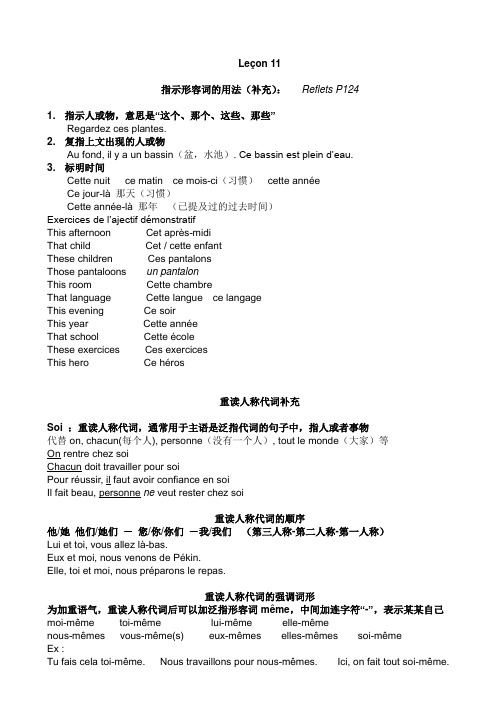
Leçon 11指示形容词的用法(补充):Reflets P1241. 指示人或物,意思是―这个、那个、这些、那些‖Regardez ces plantes.2. 复指上文出现的人或物Au fond, il y a un bassin(盆,水池). Ce bassin est plein d’eau.3. 标明时间Cette nuit ce matin ce mois-ci(习惯)cette annéeCe jour-là那天(习惯)Cette année-là那年(已提及过的过去时间)Exercices de l’ajectif démonstratifThis afternoon Cet après-midiThat child Cet / cette enfantThese children Ces pantalonsThose pantaloons un pantalonThis room Cette chambreThat language Cette langue ce langageThis evening Ce soirThis year Cette annéeThat school Cette écoleThese exercices Ces exercicesThis hero Ce héros重读人称代词补充Soi :重读人称代词,通常用于主语是泛指代词的句子中,指人或者事物代替on, chacun(每个人), personne(没有一个人), tout le monde(大家)等On rentre chez soiChacun doit travailler pour soiPour réussir, il faut avoir confiance en soiIl fait beau, personne ne veut rester chez soi重读人称代词的顺序他/她他们/她们-您/你/你们-我/我们(第三人称-第二人称-第一人称)Lui et toi, vous allez là-bas.Eux et moi, nous venons de Pékin.Elle, toi et moi, nous préparons le repas.重读人称代词的强调词形为加重语气,重读人称代词后可以加泛指形容词 même,中间加连字符―-‖,表示某某自己moi-même toi-même lui-même elle-mêmenous-mêmes vous-même(s) eux-mêmes elles-mêmes soi-mêmeEx :Tu fais cela toi-même. Nous travaillons pour nous-mêmes. Ici, on fait tout soi-même.Leçon 12 形容词1) 阳性形容词---- 阴性形容词adj. m. – adj.fe结尾un homme utile une langue utileun garçon honnête une fille honnête元音结尾Une histoire vraie vrai 真实的Son vrai père vrai 真的Un drapeau bleu Une chemise bleue以辅音结尾mon petit ami ma petite amieun grand homme 伟人une grande villeer – èreun léger accent une légère différencex – seJoyeux anniversaire/ Noël Une joyeuse ambiance a cheerful ambience特殊Ce que tu dis est faux Cette nouvelle est fausseUn vin doux a sweet wine La voix douce soft voiceUn nouveau manteau Une nouvelle robeLe chauffeur est fou La fille est folleUn étudiant actif Une étudiante activeIl est travailleur Elle est travailleuseL’ordre public La sécurité publiqueLe soleil bas the setting sun Une chaise basse2) 形容词单数---- 形容词复数Adj.sing. --- adj.pl.特殊al -- auxprincipal – principaux traveaux égal – égaux national – nationauxeau – eauxbeau – beaux nouveau – nouveauxs结尾不变Le salaire est bas Des nuages sont bas 云层低3) 形容词的位置petitUn petit problème une petite chambrenouveauUn nouveau professeur Un nouvel étudiantles nouveaux professeurs/étudiantsUne nouvelle étudiante les nouvelles étudiantesjoliUn joli nez une jolie fillebeauUn beau garçon une belle filleles beaux garçons les belles fillespremierLe premier semestre la première année补充jeuneUn jeune homme une jeune fillebonUn bon professeur une bonne idéemauvaisUn mauvais temps une mauvaise nouvellelégerUn léger accent une légère différencegrand指人时,放前放后有区别Un grand homme 伟人un homme grand 高个子指物时,一般放前面une grande famille 大的un grand immeuble 高的Ancien 的用法放前,强调和现在没有关系,以前的,前任的un ancien immeuble 以前住过的楼Qui est M. Hu Jintao ?放后面,表示旧的,老的Un immeuble ancien练习:一个古老的习俗une coutume ancienne 旧书des livres anciens 前男朋友son ancien petit ami 老朋友un ami ancien校友un ancien étudiantUn ancien ami n’est pas ton ami ; un ami ancien est ton ami depuis longtemps.4) 句子成分(补充)表语Rester Il faut toujours rester modeste et prudentDevenir il devient mon ami / gentil状语le lieu la fréquence l’objetJe viens ici pour apprendre le français. (le but)Il va à Paris en train. (le moyen)5) v.t et v.iverbe transitif indirect à ; derépondre à la questionmanquer à sa parole 不履行诺言qch convenir à qn既可以是v.t, 又可以是v.i 的动词finirIl finit ses devoirs. Le film finit à 8 heures.CommencerLe professeur commence son cours. Le cours commence à 8 heures.Leçon 13L’article contracté 缩合冠词表示所属de+le=du = of+theLe bureau du dircteur d’un Le secrétaire du parti communistede+les=des = of+the 区别不定冠词desLes revues(f.) des professeurs Les uniformes(m.) des étudiantsAttention : de+la de+l’不缩合Le magnétophone de la classe A L’année de la France en ChineLe plan de l’appartement La porte de l’université表示―去‖ 或者―在‖à+le=auM. Duval habite au troisième étage Il parle au professeurà+les=auxIls vont aux Etats-Unis Elle pense aux parents de Pascal penser àAttention : à+la, à+l’不缩合Je vais à la bibliothèque Il mange à la cantineIl travail le à l’usine Elle va à l’écoleExercices :1. the dictionary of the professor Le dictionnaire du professeur2. The apartment of the girls L’appartement des filles3. The people of the period Le peuple de la période4. The capital of Italy La capitale de l’Italie5. We go to the campus Daxuecheng Nous allons au campus de la cité universitaire6. These doctors work in the hospital Ces médecins travaillent à l’hôpital7. Lucie has somes questions, she ask the students of the third yearLucie a des questions, elle s’adresse aux étudiants de troisième année.8. Welcome to the White House Bienvenue à la Maison Blanche代词yY 代替介词à, dans, sur, chez, devant等等引导的地点状语, 指物Vous allez à Paris ? Oui, j’y vais.Non, je n’y vais pas.Pascal veut aller à Paris ?Oui, il veut y aller. Y放在实意动词前Non, il ne veut pas y aller. Ne pas在情态动词前后Ça y est ! 成功了!y无意义On y va补充:也可以代替à引导的间接宾语Cette lettre, il faut y répondre. Répondre à qch-- Penses-tu à faire tes devoirs ? penser à faire-- Oui, j’y pense.Attention : 指人,不能用y代替Je pense souvent à mes parentsJe pense souvent à eux.堂上Exercices :1. Il trouve des choses intéressantes dans ce journal. trouver 找到Il y trouve des choses intéressantes2. Elle pose des lettres sur le bureau, poser放Elle y pose des lettres3. Mon collègue veut mettre une plante devant la fenêtre. Mettre 放une plante植物Mon collègue veut y mettre une plante4. Il réfléchit à ce problème. Réfléchir 考虑Il y réfléchit.5. L’étudiant s’adr esse à son professeur.Il s’adresse à lui/ elle. 错误:Il s’y adresse国名与所用介词P123表也可以通过冠词判断Venir de——来自、出生于1. Nous allons en France en+国家2. M. Page va au Canada a+城市;a +le=au3. Nous ne voulons pas aller aux Etats-Unis a+les=aux4. Pascal et Pierre viennent des Etats-Unis de+les=des5. Je viens de Chine f国名,作地点状语,用un/de,省冠词6. Il vient du Japon de+le=du7. M. et Mme Dupont sont à Paris8. Ils veulent aller en Suisseleçon 14命令式l’impératif构成:把直陈式的主语去掉,但第一组动词tu的命令式词尾没有stu parles P142表Parle plus fort ! Parlez plus fort ! Parlons en français! Ne parlez pas très fort ! Exercices tu vous noustéléphoner à Pascal Téléphone à Pascallouer une chambre Ne loue pas de chambrevoyager à Paris Voyageons à Paris !注意:动词命令式后跟y 或en , 为了读音方便,第一组动词第二人称单数命令式词尾要加s Profites-en ! (profiter)Vas-y ! (Tu vas Va à Paris ) 第三组的动词的命令式若以元音字母结尾,也适用该法则Etre avoir的命令式特殊Etre sois soyons soyezSois prudent !Soyez le bienvenu !Soyons à l’heure !avoir 的命令式aie ayez ayonsAyez confiance à l’avenir !N’aie pas peur ! avoir peur 害怕N’ayons pas peur了解:vouloir的命令式veuille veuillez veuillons例如:--- applaudir !了解:涉及第三人称的命令式要用que + 虚拟式(下册L38 P124)如Qu’il parte tout de suite ! 让他马上走!partirQu’elle se dépêchent ! 让她们动作快点!Exercices : traduisez en françaisCome here ! Venez ici ! Viens ici !Listen ! Ecoutez ! Écoute !Help me ! Aide-moi ! Aidez-moi !Let’s go there ! Allons-y !Let us go to cinema Laissez qn 让某人Laisse/ Laissez-nous aller au cinémaDon’t eat too much ! Ne mange/ mangez pas tropfollow me ! Suivez-moi Suis-moiRead after me ! Liez après moi ! Lis après moi !Pay attention ! Fais/ Faites attention !Be nice please ! Soyez/ Sois gentil/ gentille !Let’s be courageous ! courageux / courageuse Soyons courageux !Wait a minute. Attends/ Attendez une minuteExercice VI. (6) P146最近将来时le futur procheAller(助动词)+ inf. = be going toNous allons faire ces exercices. Il va être deux heuresC’est presque l’heure, on va commencer le coursIls vont finir leur travail tout de suite (leçon 14)在倒装疑问句中,助动词和主语倒装Allez-vous souvent voir vos parents ?Que vas-tu apprendre ? = Qu’est-ce que tu vas apprendre ?Conjugaison ALLERExercices : traduisez en françaisHis parents are going to France. Ses parents vont aller en FranceThis afternoon, he is going to see his English friends.Cet après-midi, il va voir ses ami(e)s anglais(es)I am going to take the underground to go to the Higher Education Mega Center.la cité universitaire/ le pôle universitaireJe vais prendre le métro pour aller à la cité universitaire/ au pôle universitaire. Qu’est-ce que tu vas faire après le cours de français?法语钟点表达法1/ Quelle heure est-il ? Vous avez l’heure? Tu as l’heure ?Il est ... une heure/ trois heures/ midi/ minuit (区minute)midi=douze heuresMinuit = vingt-quatre heures2/ 表示半demi 是形容词Une demi-heure Une heure et demieIl est trois heures et demie Il est midi et demi midi m.Il est minuit et demi minuit m.关于demiEx: The baby is one and a half years old. Cet enfant a un an et demi.3/ 表示刻quart m.Il est quatre heures et quartIl est sept heures trois quarts 不用etIl est minuit et quart4/ 表示分minute f.Il est huit heures une (une minute)Il est neuf heures dixIl est une heure vingt-cinq5/ 表示差moins adv. 一般是差15分钟以内=toIl est six heures moins cinqIl est onze heures moins le quart = (11 heures et quart)6/ 日常生活使用12小时制Il est cinq heures du matinIl est trois heures de l’après-midiIl est six heures du soirdu matin de l’après-midi du soir 在不出现混淆时可省7/ 火车时刻表等则用二十四小时制,并且不用半、刻、差等形式Il est dix-neuf heures trente =Seize heures quarante-cinq =douze heures quinze =补充:Seconde f. 秒Il est une heure deux minutes trente (secondes)注意1)2)略3)4)比较1. Il est onze heures2. Il vient à onze heures3. Le cours commence à huit heures4. Chaque jour il se couche à minuit疑问句:-- A quelle heure vient-il ?Exercices : traduisez en françaisWhat time is it? quelle heure est-il ?Have you got the time? vous avez l’heure ?It’s seven o’clock. Il est sept heuresIt's midnight. Il est minuitIt's twelve o'clock. Il est midihalf an hour. Une demi-heurenine hours and a half Neuf heures et demiea quarter past seven Sept heures et quartIt’s three quarters past four Il est quatre heures trois quarts It’s one minute past eleven Il est onze heures uneIt’s a quarter to seven Il est sept heures moins le quart It’s eight to five Il est cinq heures moins vingt-huit It’s three thirty in the morning Il est trois heures trente du matin It’s nine o’clock at night Il est neuf heures du soirHe begins his work at noon Il commence son travail à midiHis father takes the train at thirteen fifty - threeSon père prend le train à treize heures cinquante-troisLeçon 15直接宾语人称代词词形Me (m’) te (t’) le la(l’) nous vous lesEx : Il ______ aime.位置Il nous regarde 变位动词前Il veut me voirIl ne m’écoute pas 否定句放在ne 后面,动词前面-Vous aimez ce livre ? – oui, je l’aime beaucoup. -- non, je ne l’aime pas 注意省音-Vous allez voir Philippe ?-Non, je ne vais pas le voir 在有助动词的句子中,放在原型动词(实意动词)前 ;同y Je ne vais pas y allerVous pouvez me suivreVous devez m’écouter 省音命令式Excusez-moi 直宾放在动词后,me变成moi ;te变成toi其他代词不变excuser qn Ne m’excusez pasRegarde-toi dans la glace te 变成toi Ne te regarde pas dans la glaceExcusez-nous 不变Voilà un billet, prends-le 不变Ne le prends pasNe me regarde pas 否定命令式中,放在动词前C’est un menteur, ne l’écoute pas.Ex : 把上面的肯定命令式变成否定命令式补充:1/ me te nous vous只能指人Le la les 可以指人,也可指物Ex : Connaissez-vous Magalie ? Oui, je la connais. (connaître)Cette voiture, je vais l’acheter.2/ 代词le还可以代替不定式或者从句,如:- Vous pouvez m’aider à monter le courrier ?- Oui, je peux le faire.补充练习:(堂上作业)用合适的代词回答下列问题:综合1. Allez-vous lire ces livres ? Oui, je vais les lire.2. Vous allez en Chine, n’est-ce pas ? Oui, j’y vais.3. Est-ce que Michel va voir ce film ? Oui, il va le voir.4. Nous devons suivre ce monsieur ? Oui, vous devez le suivre.5. Jacques travaille souvent avec vous ? Oui, il travaille souvent avec nous / moi.6. Faites-vous ces exercices ? Oui, je les fais.7. Est-ce que tu vas au bureau ? Oui, j’y vais. Non, je n’y vais pas.8. Vous allez dans le salon avec Catherine ? Oui, nous y allons avec elle.9. Paul et Marie viennent à 5 heures ? Oui, ils viennent à 5 heures.10. Est-ce que Philippe veut aller à Beijing avec ses amis ? Oui, il veut y aller avec eux.用合适的代词代替划线部分(综合):1. Il va chez son amie ce soir. Il va chez elle ce soir2. Elle lit des journaux dans la salle de lecture. Elle y lit des journaux3. M. Martin habite à Shanghai depuis quinze jours. Il habite à Shanghai depuis 15 jours.4. Après le dîner, je regarde un peu la télévision avec mes parents.Je regarde un peu la télé avec eux5. Je peux finir mon travail avant 4 heures. Je peux le finir avant 4 heures6. Je comprends cette leçon. Je la comprends7. Chaque année, Pauline passe ses vacances à Xian.Pauline les passe à Xian8. Ils ne veulent pas aller à l’hôpital.Ils ne veulent pas y aller9. Les Chinois aiment beaucoup le thé. Les Chinois l’aiment beaucoup10. Le professeur est devant les étudiants. Le professeur est devant eux泛指人称代词onOn 作主语只能指人动词用第三人称单数1、指某人身份不明或者未说明的人On frappe à la porte 有人......On te téléphone 有人...... téléphoner à qn 间宾2、任何人所有人= tout le mondeOn ne réussit pas à un examen, si on ne travaille pas assezOn peut toujours trouver une issueOn apprend à tout âge3、代替其他人称代词, 一般代替nous ;On ne la voit pas beaucoup = nousOn ne peut rien te cacher = je/nous cacher qch à qnAlors, on n’est pas content ? = tuOn ne me répond pas =ils répondre à qn/qch注意:1、代替哪个代词,根据上下文而定Mon mari et moi, on aime faire du sportNous, on est des gens simplesOn continue (en cours)On va commencer le cours (en cours)2、On 在si ou et oùqui que 等后,可写成l’on,为了读音方便Si on travaille beaucoup, on fait des progrès (si l’on也可)Il dit qu’on peut y aller en train 或il dit que l’on peut y aller en train3、On 后面的表语有性数变化On n’est plus ami sQuand on est jeune, on est coquette coquet爱打扮的On est contents. On est contentes.书本练习P163 VII第二组动词变位第一组–er结尾规则数量最大第二组ir结尾规则常用的不多第三组不规则逐个记忆(课后变位表常用的大概20多个)课后单词变位总表FinirJe finis tu finis il finit nous finissons vous finissez ils finissent同réussir choisir注意:不是所有的ir结尾动词都这样变,如Sortir savoir 是第三组不规则的变位,需要查动词变位表leçon 16 (Leçon 30 有补充)代词式动词Le verbe pronominal – v.pr.Je m’appelle Hélène ( s’appeler )和自反代词me, te, se, nous, vous, se一起使用的动词叫代词式动词Se laver 代动词Je me lave tu te laves il se lave elle se lave nous nous lavons vous vous lavez ils se lavent elles se lavent自反代词的人称的性数和主语一致并不是所有的动词都有代动词的形式,参考dictionnaire用法1) 自反意义:动作作用于主语本身Je me lave 直宾(laver qch/qn ) 我洗澡Elle se lave les mains 间宾她自己洗手1、看是否是及物动词2、看是否有直接宾语练习:se表示自反意义时,判断是直宾还是间宾Il s’assoit. (s’asseoir) a sseoir qn使某人坐Elle se repose. (se reposer) reposer qch/qn 使休息Elle s’amuse beaucoup pendant les vacances d’hiver (s’amuser) amuser qn 使高兴Je me couche à 11 heures (se coucher) coucher qn 使躺下Je me fais une tasse de café (se faire) faire qch pour qnIl se sent bien (se sentir) sentir qn + adj. 感觉Vous vous habillez avec goût (s’habiller) habiller qn 给某人穿衣Elle aime se regarder dans le miroir (se regarder) regarder qnJ’habille Pascal2) 相互意义:主语是复数(包括on)Les deux amis se rencontrent 直宾rencontrer qnOn se rencontren Nous nous rencontronsIls se serrent la main et se disent bonjour 间宾Dire qch à qn补充:当se是相互意义时,判断是直宾还是间宾Une jolie fille et un beau garçon vont se marier (se marier) marier qn à qn使qn和qn结婚Pierre et Annie se téléphonent de temps en temps (se téléphoner) téléphoner à qnOn s’écrit souvent (s’écrire) écrire qch (une lettre) à qnOn doit s’aider entre nous (s’aider) aider qnRépondez aux questions :Est-ce que dans votre classe de français, quand ils se retrouvent ou se quittent, les étudiants ·se serrent la main ? v.t. Oui, ils se serrent la main. Non, ils ne se serrent pas la main ·s’embrassent ? v.t.·se saluent ? v.t.·se sourient ? v.i.Est-ce que dans la classe·ils se parlent en français ? v.i.·ils s’aident à travailler ? v.t.·ils se corrigent mutuellement ? v.t.Quelles sont les relations entre eux ?·est-ce qu’ils s’aiment bien ? v.t.·est-ce qu’ils se critiquent ? v.t. ils ne se critiquent pas·est-ce qu’ils s’ignorent ? v.t. ignorer·est-ce qu’ils ne s’aiment pas ? v.t.Si, ils s’aiment bienEst-ce qu’en dehors de la classe·ils se téléphonent ? v.i.·ils s’invitent ? v.t.·ils se parlent ? v.i.·ils ne se rencontrent pas ? v.t.补充:P425 L303) 被动意义La cité u niversitaire se trouve à l’île de Xiao Gu Wei (se trouver)Comment ça s’écrit? (s’écrire)Comment ça se prononce ? (se prononcer)Ce mot ne se dit plus. (se dire)Cette année, les téléphones mobiles se vendent bien (se vendre)4) 绝对意义:自反代词不是宾语,没有语法作用,只是固定用法Il s’adresse àson lecteur français car il ne sais pas comment traduire ce mot (s’adresser à qn 询问某人)Nous nous souvenons souvent de nos anciens professeurs (se souvenir de想起,记得)Les filles se moquent toujours de Philippe (se moquer de嘲笑)La mère s’occupe de ses enfants (s’occuper de 照顾)有的动词的代动词可以有多种意义se voirIl se voit dans la glaceIls se voient dans la rueCette faute ne se voit pas位置自反代词位置和宾语人称代词相同放在动词前Est-ce que tu te couches tôt le soir ? = Te couches-tu tôt le soir ?Comment vous appelez-vous ?你几点洗澡?(2) se laverA quelle heure est-ce que tu te laves ?A quelle heure te laves-tu ?她叫伊莲娜吗?(2)Est-ce qu’elle s’appelle Hélène ?S’appelle-t-elle Hélène ?我/他们/我们想洗澡。
中考英语之指示代词总结
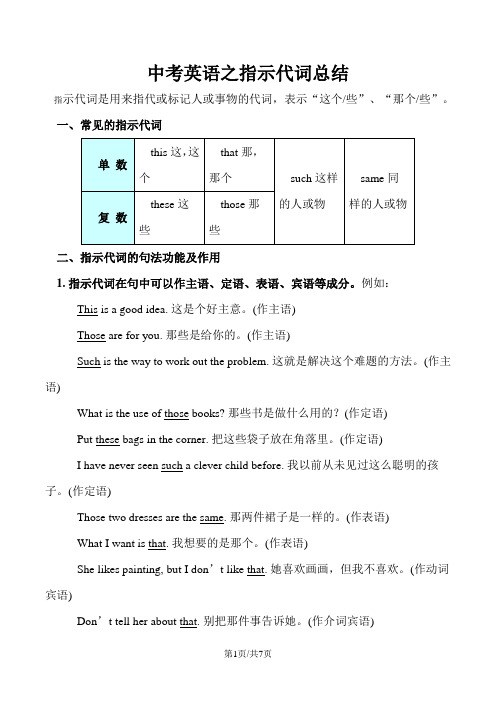
中考英语之指示代词总结指示代词是用来指代或标记人或事物的代词,表示“这个/些”、“那个/些”。
一、常见的指示代词二、指示代词的句法功能及作用1.指示代词在句中可以作主语、定语、表语、宾语等成分。
例如:This is a good idea. 这是个好主意。
(作主语)Those are for you. 那些是给你的。
(作主语)Such is the way to work out the problem. 这就是解决这个难题的方法。
(作主语)What is the use of those books? 那些书是做什么用的?(作定语)Put these bags in the corner. 把这些袋子放在角落里。
(作定语)I have never seen such a clever child before. 我以前从未见过这么聪明的孩子。
(作定语)Those two dresses are the same. 那两件裙子是一样的。
(作表语)What I want is that. 我想要的是那个。
(作表语)She likes painting, but I don’t like that. 她喜欢画画,但我不喜欢。
(作动词宾语)Don’t tell her about that. 别把那件事告诉她。
(作介词宾语)2. this, these, that, those的用法区别①this和these是近指代词,指时间或空间较近的人或事物;that和those是远指代词,指时间或空间上较远的人或事物。
例如:This present is for her and that one is yours. 这个礼物是给她的,那个是你的。
I don’t like these books. Could you please show me those ones? 我不喜欢这些书。
能不能把那些把给我看一看?—Look! What’s ________ in the sky? 看!空中的那个是什么?—It looks like a kite. 看起来像一个风筝。
- 1、下载文档前请自行甄别文档内容的完整性,平台不提供额外的编辑、内容补充、找答案等附加服务。
- 2、"仅部分预览"的文档,不可在线预览部分如存在完整性等问题,可反馈申请退款(可完整预览的文档不适用该条件!)。
- 3、如文档侵犯您的权益,请联系客服反馈,我们会尽快为您处理(人工客服工作时间:9:00-18:30)。
注:1. n表示名词。
如法语中的ces gens-ci(这些人)。
2 此处“阴阳单复”指的是“指示形容词”后接名词的性数。
如西语中“这个办公室”,办公室oficina为阴性,就要选择esta,答案为esta oficina.
3 法语中,当ce后接“以元音字母或哑音h开头的阳单”时候,将ce换成cet. 如cet homme.
注:1 西法中,“中性指示代词”没有复数,只代指“这个,那个”
2 西语中“阴阳性”的指示代词都带重音符号,中性代词不带。
而西语中的指示形容词没有重音符号,不可搞混。
3 法语中,Ça用途广泛,指“这个,那个”都可以。
4 西语中所有指示代词都单独使用;
法语中celui, celle, ceux, celles这四个指示代词都不可单独使用,后面必须接限定成分(比后接de+补语,先行词qui que quoi等+从句),其余代词都可以单独使用。
西语中有t的是这个,没t的是那个。
